What is a product backlog | Examples and how to write it
A product backlog is a prioritized list of items and features needed to achieve a goal. Generally, for each product in development he has one Product Backlog, to which he assigns one team.
The Product Backlog is a plan or business goal for how the product will evolve. Developers can use product backlog items to get results faster.
In Agile, Product Backlog items change. And not all items in the Product Backlog are completed. It is necessary to prioritize and refine the Product Backlog.
The Product Owner is the owner and responsible person for the Product Backlog.
What is Product Backlog in Agile?
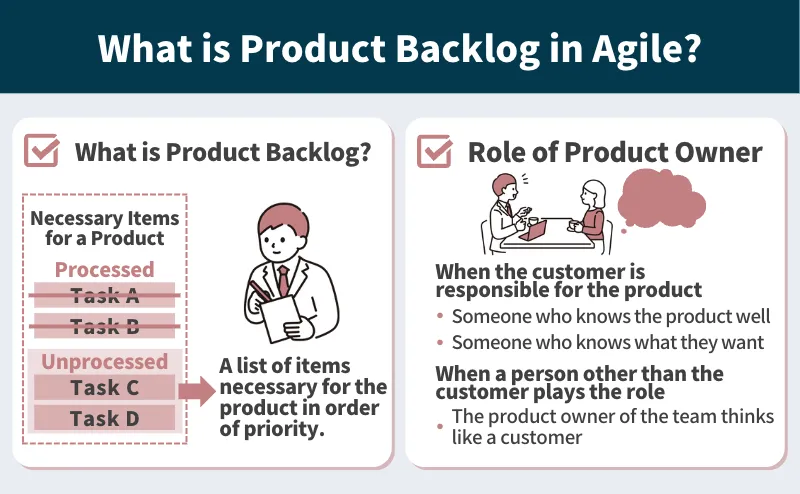
A Product Backlog in Agile development is a prioritized list of deliverables (such as new features) that should be implemented as part of a project or product development. It’s also a business goal. You could call it a wish list. Typical items in the product backlog include feature additions, bug fixes, etc.
Overview
What does the Product Backlog look like? “Backlog” refers to the “backlog”. In other words, the “product backlog” can be said to be the “unfinished product list”. In Scrum, this “item” is called a “product backlog item”. Items are appropriately sized and prioritized. The product backlog is a list of outstanding work, ordered by priority, for the items needed for the product.
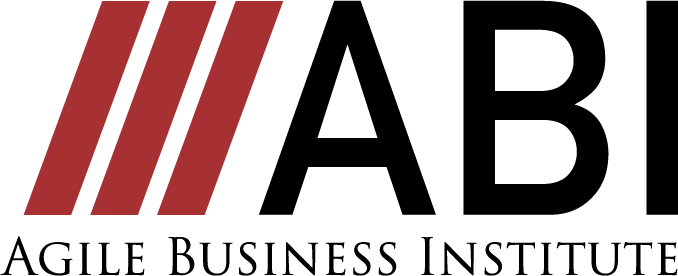
Role
Who will be the Product Owner? Ideally, it should be the customer who knows the product well and knows what they want. If not, try to think like a customer on your team as a product owner. All Scrum Team members support the Product Owner. If the team disagrees and a decision cannot be made, the Product Owner must decide. Many companies change who plays the role of Product Owner each week. Anyone who has been trained can take turns being a Product Owner.
Elements in the Product Backlog
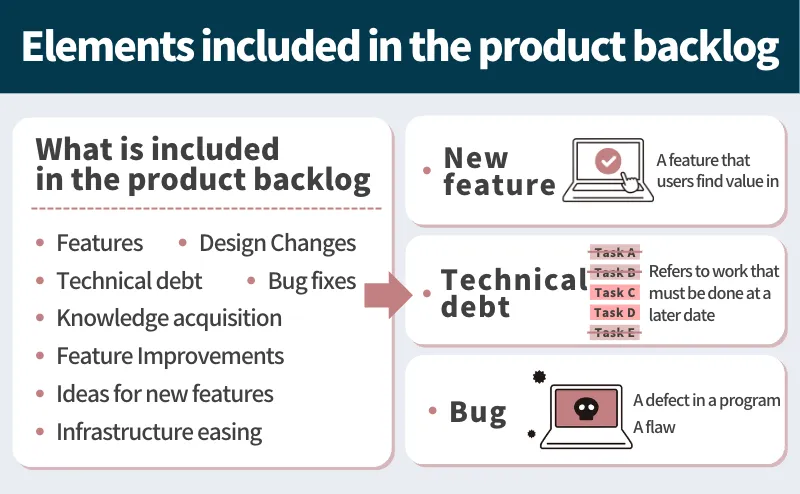
The product backlog typically includes features, bug fixes, technical debt, knowledge acquisition, new feature ideas, feature improvements, design changes, infrastructure changes, etc. A product backlog item like this is a large to-do list, a clearly divided piece of work that has not yet been assigned to the product.
New function
Also called a new feature. Features are product features that users find valuable. Features can be complex or simple. The Product Owner must have a good understanding of what users, customers and stakeholders need and want most.
Technical debt
Technical Debt is primarily software development work that is incurred today due to shortcuts taken and that will have to be done at a later date. Developers usually have to balance quality and speed. Technical Debt means that you pay back the “buy” later for the convenience you get by taking shortcuts. Technical debt tends to be relegated to the bottom of the backlog. It is also often used to refer to maintenance issues.
Bug
It comes from the English word “bug” and refers to a defect, error, or defect in a computer program. Bug fixing is, as the name suggests, the work of fixing bugs. The Scrum Team should react quickly to bug fixes. Some bugs are important enough to interrupt the team’s current sprint, while others can be moved to the next sprint, but they need to be kept at the top of the product backlog so the team doesn’t forget them.
How to create and write a product backlog
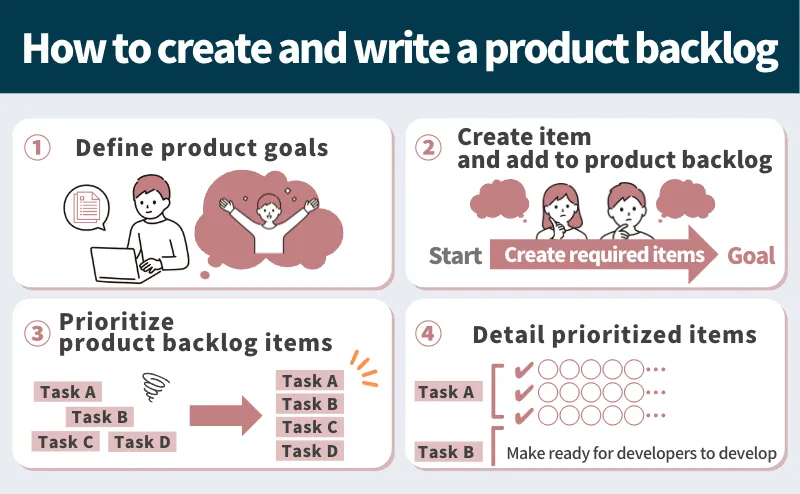
Here’s how to make a product bag.
Step 1. Determine product goals
When creating the product backlog, you first need to determine the product goal. A product goal is a “vision” or a “mission”. There are frameworks such as Inception decks that clarify this, and you might want to try using them.
Step 2. Create a Product Backlog item and add it to the Product Backlog
After formulating the product goal in step 1, create product backlog items to achieve it and add them to the product backlog. Additions are made by everyone on the Scrum Team, not just the Product Owner. User story templates are often used.
Technical implementation means are determined by the developer.
As (persona)
I can (Feature)
so that (passionate why)
Step 3. Prioritize product backlog items
Next, prioritize the product backlog items created in step 2. If you can’t prioritize, your Product Backlog may be too big and you should consider splitting it up.
Step 4. Refine high-priority product backlog items
Finally, detail the high-priority product backlog assigned in step 3, and make it ready for development by developers.
This includes creating acceptance criteria by the Product Owner, defining completion criteria (including non-functional requirements) and making sure everyone on the Scrum Team understands what they mean.
Product backlog example
Here is an example of a Product Backlog.
- Example 1) I want to make it easy for guests to make hotel reservations.
- Example 2) The contributor wants to consult freely on the site
- You can make hotel reservations as a guest
- You can cancel your hotel reservation as a guest
- As a guest, you can change the reservation date and time
- As a poster, you can post consultations and concerns
- Posts can be in public or private mode
- Site administrators can reply to posters
How to prioritize the Product Backlog
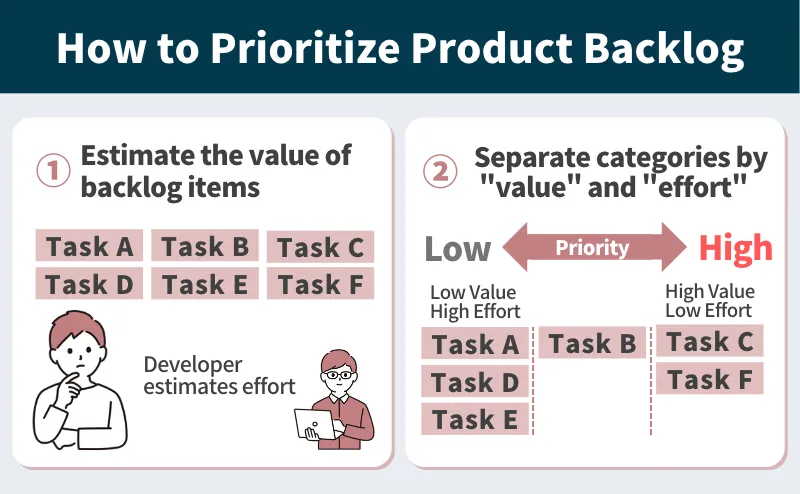
The Product Owner should prioritize the Product Backlog.
When thinking about prioritization, first estimate the value of the backlog item. Effort estimates are provided by the developer.
If the item has dependencies, it takes precedence. Once that’s done, divide the value and effort into categories. High-value, low-effort items are prioritized first, and low-value, high-effort items are placed at the very end of priority or removed from the backlog if possible.
- Kano Model (A model originating in Japan that is said to be used by Apple Inc. A method of classifying customer satisfaction and service quality factors)
- Eisenhower Matrix (Method of prioritizing according to urgency and importance)
Prioritize using the methods above.
Advantages of Product Backlog in Agile

The advantages of the Product Backlog are:
- Listed for easy maintenance
- Easy to prioritize and change as things change
- Able to think about products from a long-term perspective
Compare the difference between Product Backlog and Sprint Backlog
Product backlog
A sprint backlog is a list of tasks to complete one product backlog item during the sprint period.
The Product Backlog is a larger business goal than the Sprint Backlog.
Sprint backlog
A Sprint Backlog is a list of technical tasks to achieve that business goal.
The purpose of the Sprint Backlog is to accomplish one product item.
The product backlog is owned by the PO (product owner), while the sprint backlog is owned by the Dev developer (SM coaches the developer).
Product Backlog and Sprint Backlog Comparison Chart
| Product backlog | Sprint backlog | |
|---|---|---|
| Overview | Sprint-sized business goals (value chunks of features and services) | Materialization of one product backlog (technical list/task list) |
| Owner (person in charge) | PO (Product Owner) | Dev developers (SM coaches developers) |
| Purpose | Aiming to maximize product value | The purpose is to achieve one product item |
Importance of product backlog review (maintenance)

After the above steps, the Product Backlog is completed. The product backlog is not finished once completed, but in a highly uncertain world, it is necessary to constantly maintain it according to the market and needs. Otherwise, it will end up a meaningless Product Backlog.
Priority maintenance
Reassessing priorities is an area that tends to be overlooked. This is the Product Owner’s responsibility and should basically always be done. However, product owners are often busy, so in order to perform priority maintenance efficiently, it is necessary to perform priority-based maintenance and modify and update priorities within the scope of the change.
Product backlog item maintenance
Product Backlog item maintenance is accomplished by adding, updating, and deleting the Product Backlog itself. We recommend the Refining Cafe. This is a way to spend 15 minutes a day reviewing one Product Backlog item to see if it’s up to date.
Summary
What did you think?
As you can see, the Product Backlog in Scrum greatly influences the success of a project. Once created, the Product Backlog can be flexibly maintained and can be edited, deleted or updated at any time.
The Product Backlog Scrum drives the speed of product releases and encourages product growth. It is essential for achieving business goals.
コメント